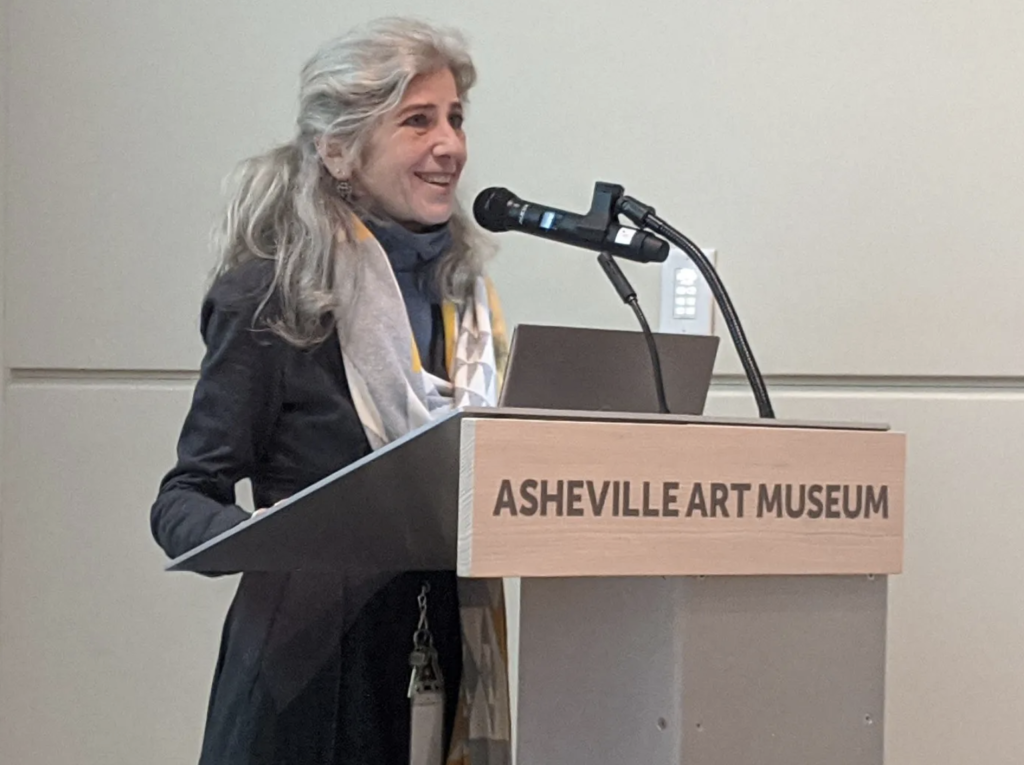
The Asheville Art Museum. // Photo credit: David Huff
By Sally Kestin, Asheville Watchdog
The Asheville Art Museum, glistening through its glass exterior in the downtown heart of Pack Square, earns acclaim for its prized collection of American and Appalachian artwork. But behind the facade, it gets ugly, an Asheville Watchdog investigation found.
Former employees have complained of a workplace that two board members described in a 2021 summary as “beyond toxic.”
“The word used by three former staff is ‘traumatic,’ ” the board members, David Huff and Darren Green, wrote.
The nonprofit museum has collected millions of dollars in donations, admissions, grants, and memberships, and includes among its supporters Buncombe County and the City of Asheville, courtesy of the taxpayers.
In charge of it all is a board of trustees with full authority over the museum’s affairs, and one that operates out of public view, often yielding to the will of its long-time executive director, Pamela Myers.
Few outside the museum noticed when, this spring, five board members — one-fourth of the trustees — resigned.
The board has twice brought in an executive coach — in 2015 after six former employees complained about the museum’s management to trustees, and again in 2021 after eight other ex-staffers voiced their concerns to Huff and Green.
The museum appears to be “in really good shape,” said board member Michelle Weitzman. “It’s financially healthy. They win awards. It looks really pretty on the outside. But the culture of fear in employees, the morale and the attrition is horrendous.”
Myers, the museum’s executive director for 27 years, declined to be interviewed by Asheville Watchdog. She and other current board members, as well as past board chairs, would only answer questions submitted in writing.
“We regret that certain employees felt their experience at the museum was not what they would expect,” Herbert “Butch” Patrick Jr., the board chair when the 2021 complaints surfaced, wrote in response to questions from Asheville Watchdog.
Patrick said the board has taken steps including hiring a human resources associate, and that initial feedback from the executive coach working with senior leaders has been encouraging. He said, “We continue to have confidence in Ms. Myers’s leadership going forward.”
Capital Campaign a Success
The November 2019 reopening of the $24 million museum in the center of downtown marked the crowning achievement of one of the largest and longest capital projects in Asheville’s history, a campaign spanning more than a decade. Myers spearheaded the construction and fundraising.
“I don’t know many people that could have gotten that done except Pam because she had a laser focus,” said former board member David L’Eglise, who left the board about five years ago.
“I always felt like the museum, as far as financially speaking, was very solidly run and on very sound footing, and Pam, coming from New York, she seemed to bring a national element to Asheville that was very positive,” he said. “It allowed the museum to almost punch above its weight.”
The building “is completely paid for and debt-free, and a $6 million-plus endowment has been established,” wrote Paul Saenger, the museum’s current board chair. Construction was a success “due to the strong and capable leadership of Ms. Myers,” her fundraising skill, and “excellent relationships in the community and art world,” he wrote.
Huff agreed the museum is “a beautiful building, and for a city our size to have an art institution is pretty cool.”
But, Huff said, “One former employee said to us, ‘Wow, it’s an amazing museum, the art collection is impressive, but at what cost?’ ”
‘Run Like a Dictatorship’
Employee complaints have dogged the museum for years. Asheville Watchdog interviewed 11 former staffers and one current employee and reviewed a half-dozen letters to the board dating to 2015.
Common themes emerged: Employees complained of high turnover that led to them filling in for open positions for months at a time with no additional compensation and salaries below or near Asheville’s living wage of $40,768 a year. They described being blamed for failures they didn’t cause and harshly criticized in front of other employees or museum guests.

Pam Myers has been the focus of employee complaints. // Photo credit: Lindsey Grossman
The museum is “run like a dictatorship, and everyone else is like servile to the dictator,” said one of several former employees who spoke on the condition that they not be named, fearing possible retaliation by some in the arts community. “I watched so many good, qualified people come in and just get wasted because they got so frustrated with the lack of communication and the poor treatment of staff.”
Lacy Nance started in February as the museum’s adult programs and community outreach associate and left in October. She said Myers was “extremely hard to talk to” and treated staff like “we are nothing.”
Part of Nance’s job was to work with other organizations to create programs and events to bring people to the museum.
“It’s been extremely hard for me to connect with the community because [Myers] has burned bridges with a lot of people,” Nance said.
Asheville Watchdog reached out to two prominent arts organizations and a gallery in Asheville, but none would speak publicly about Myers or the museum.
Saenger wrote that the museum would not comment on “employee-specific information or individual employee comments.”
The museum has experienced high turnover, a problem common to many nonprofits, but former employees said Asheville’s museum management and working conditions contributed to the exodus.
Matilyn Hull worked at the museum for a year in communications before resigning in August. “I saw 11 full-time staff members leave, and that’s about half of the staff,” she said.
At times Hull said she was the only one, or one of two people, in what had been a five-person department, and 10 months into her tenure — at the age of 25 — she became the most senior member, juggling multiple responsibilities and training new hires.
“It’s like a recipe for burnout,” she said.
In August, Hull left the museum with no other job lined up.
That same month, the museum awarded staff pay raises to address “the lag in employee pay,” according to a letter sent to employees.
Speaking to Former Employees ‘Unethical’
Trustee Huff said he became concerned about working conditions after the June 2020 resignation of Lindsey Grossman, the museum’s communications manager.
Grossman “hit it out of the park” promoting the museum’s reopening in the fall of 2019, Huff said. In February 2020, Grossman received a raise for what Myers described as “excellent work.”

Lindsey Grossman said Myers criticized work after approving it. // Watchdog photo by Starr Sariego
But the next month, Grossman’s two elementary school children were sent home in the Covid lockdown. Grossman said she needed time to supervise her children during the day and made several proposals to realign her schedule, including working early mornings, nights and weekends.
She said Myers accepted one proposal: that she work four 10-hour days a week, on the condition that she would have to use personal leave for the fifth day because her contract was for five days a week, according to a state labor agency document. Grossman said her personal leave days would have run out in less than three weeks.
“I didn’t want to resign,” Grossman told Asheville Watchdog. “They were giving me no choice.”
Huff said he “was aghast” at the museum’s lack of flexibility.
“If you’re a working mom, and they didn’t help you during Covid …” he said. “This is a nonprofit organization. You expect that from Google or Apple or Amazon.”
Grossman received Covid-related unemployment for several months, but the museum appealed her eligibility. After a hearing last year, the state labor agency found Grossman “left work for personal reasons not attributable to the employer.” Grossman was ordered to repay $7,215, money she said her family already spent. She has hired a lawyer, and said the labor agency is reviewing the decision.
After her resignation, Grossman met with Huff and described Myers micromanaging employees and holding up decisions. Grossman said Myers berated her for work even after Myers had already approved it.
According to Huff, Grossman said, “Other employees have had similar experiences. I said, ‘Well, if anybody wants to talk to us,’ and then employees started reaching out.”
Eight other ex-staffers came forward. Board member Darren Green sat in on about five of the meetings. A May 2021 summary of those meetings, prepared by Green and Huff and delivered to Butch Patrick, the board chair at the time, described “extremely high” turnover, a “culture of fear,” and “abusive” behavior by Myers.
“She berates, attacks and humiliates employees,” the summary said. “She cusses at them. She belittles them. She does this in front of other employees.”
Patrick told Asheville Watchdog he was surprised and concerned. But he also told Green and Huff, according to Green, that it was “unethical” that they had “talked to former employees about their experience at the art museum.”
“I felt it was my responsibility to know,” Green said.
Huff also considered it his “fiduciary responsibility as a trustee to hear from employees if there’s an issue with management.”
“Our job is not simply just to show up and go to fundraisers, help bring in money and enjoy wine and cheese events,” he said.
Saenger, the museum’s current chair, said in a written response to Asheville Watchdog that the board’s Code of Ethics states board members “must avoid giving directions to, acting on behalf of, or soliciting administrative information from staff personnel.”
If serious matters arise, Saenger wrote, “they should be reviewed by someone independent of the process, with no personal connections or agenda.”
Huff and Green said they’d never seen the Code of Ethics but that they had met with former employees and were not soliciting information from current staff.
Patrick created a committee to review the employee complaints. Huff, a consultant on leadership and governance, said, “I was told I would not be on that committee.” Neither was Green, the board’s secretary.
The committee, Saenger wrote to Asheville Watchdog, was selected by Patrick as chairman and included “individuals with exceptional HR experience as he felt appropriate.”
A consultant retained by the committee, “while not validating or discounting every observation of past employees,” recommended improvements in the museum’s human resources structure, Patrick wrote.
The board created a human resources committee, hired an HR associate (the person had left as of mid-October for another job), and brought in Berkana Consulting Group in Black Mountain to provide consulting and training to senior management.
Myers “has been very positive about the coaching and feedback she is receiving,” wrote board vice-chair Kevin Click, a former human resources executive. “She seems very committed to addressing the concerns raised, and I believe we are on a solid path forward.”
Similar Complaints in 2015
The museum’s board formed a committee in 2015 after former employee Candace Reilly and five others raised similar concerns to the trustees.
“The way the museum is being managed under Pam Myers is reprehensible and unsustainable,” Reilly wrote in July 2015. Myers harshly criticized staff when she did “not like something. Oftentimes this is in the presence of other staff, volunteers or the public.”
Lauren Bellard, a former Curatorial Fellow, wrote to the board in 2015 that high turnover, low pay, and Myers’s belittling of employees made for a “toxic work environment.”
“The place constantly felt like a sinking ship,” she wrote.
The board chair at the time, Lin Andrews, wrote to Asheville Watchdog that on the advice of lawyers she consulted, she formed an ethics/audit committee and that the allegations “were fully investigated.”
“Coaching and feedback was provided to Ms. Myers,” Andrews wrote. “Staff morale issues were addressed with Ms. Myers as part of her annual performance review.”
‘Not a Transparent Organization’
Art educator Kelly Baisley wanted the museum’s board to know about her experience after she resigned this spring. She wrote to the board but said she did not know how to get her letter to trustees — or even who they were.
The museum does not list board members on its website, an unusual omission for nonprofits of any size, much less one that has received significant community and government support. Saenger wrote that a list of board members can be found on the museum’s tax return, which is available only on request. The most recent return that the museum provided is for 2020 and lists 12 trustees who are no longer on the board.
Huff said the museum is “not a transparent organization.”
Myers required a Watchdog reporter to come to the museum to review the current board members, annual audits and bylaws, and prohibited photocopies.
The museum declined to make available Myers’s contract, her salary, or even her age (she’s 65). Myers made $164,269 annually, according to the 2020 tax return.
Asheville Watchdog checked the websites of a dozen similar-sized nonprofits in Buncombe County. All listed their board members, and the majority posted tax returns and/or audits.
“We believe our information is fully transparent,” Saenger wrote.
‘Verbal’ Board Member Loses Vote
Michelle Weitzman holds a seat on the board as president of the Docents Association. Docents are volunteers who lead tours of the museum.
From 2019 to 2021, the docent’s representative was Sarah Reincke, and since July 2021, it has been Weitzman. Both said they were regularly in the museum and raised concerns to the board about the treatment of employees.
“We were a bother,” Reincke said. “We were verbal.”
Weitzman sent a series of emails from March to May 2022 to Patrick, the board chair, and to Kevin Click, the human resources committee chair, referring to a “large morale deficit” and “enduring problem” of a stressful workplace.
Baisley resigned during that time, on March 31. “Many of us are going above and beyond, covering far more than our own job responsibilities, regularly working in excess of 40 hours … only to be criticized, micromanaged and belittled,” she wrote in her resignation letter.
Baisley wrote a second letter April 19 just to the board. After filling in twice for vacancies in the learning and engagement department, including seven months acting unofficially as director, Baisley wrote that she had requested a performance review, her first in her nearly three years there, and a raise. Instead, Myers and Lindsay Rosson, director of finance and operations, questioned her behavior, she wrote.
One example she said she was given: Several days before, Baisley and two others had asked Rosson during a meeting if a part-time employee could take on extra hours to ease the workload in Baisley’s department.
“We were met with an explosion of anger,” Baisley wrote. According to the letter, Rosson told her she had “not gone through the correct channels.” She said Rosson later apologized but then raised the incident as an example of Baisley’s inappropriate behavior. Rosson did not respond to requests for comment.
Baisley addressed her letter to the “Board of Trustees” and said she asked Weitzman, the only trustee she knew how to contact, to deliver her letter.
On April 25, Weitzman sent Baisley’s letter to Patrick, the board chair, but said by the next board meeting on May 17, he had not distributed it to all members. During that board meeting, which was virtual, Weitzman emailed the letter to the entire board.
“You are all individually and legally responsible as a board member to constantly assess, oversee and change direction to move this institution forward, not simply agree with the Executive Director’s agenda,” Weitzman wrote. “If you have the courage and bravery to do the right thing, read on.”
She wrote that the board’s executive committee “is making decisions on behalf of the board behind closed doors without informing all of the board of trustees, which is unconscionable.”
Patrick responded in an email to the board, writing that the executive committee had wide latitude to act on behalf of the board. “Employee issues that are elevated are taken seriously and addressed appropriately.”
At that same meeting in May, the board adopted new bylaws. Weitzman noticed one significant change: Her voting power had been eliminated.
The previous bylaws gave the Docents Association’s president “all the rights, duties and responsibilities of elected Trustees, including the right to vote.” The updated version described the Docent president’s role as “a non-voting member.”
Weitzman told Asheville Watchdog she believed the change was in retaliation for her outspokenness. “When I started talking about the HR situation and asking questions, it just happened to coincide with the time to be able to adjust bylaws,” she said.
Patrick said the revision was “part of a normal review … to ensure good governance, best practices, and consistency.” He said the revisions were completed in early April and “in no instance or circumstance were any changes recommended or contemplated due to actions by any individual board member.”
Five Resignations
Tensions on the museum board reached a tipping point this spring over the future of trustee Terri Sigler, one of two Black board members. The other was Omari Simmons.
Sigler, along with Green, co-chaired a diversity, equity, accessibility and inclusion committee created after the Black Lives Matter protests in 2020. The committee brought in a consultant to conduct diversity training for the board and oversaw an equity audit that included employees, board composition, and collections.
Huff, who served on the equity committee, said the museum reflected diversity in its collections but needed improvement in the makeup of the board, staff, and vendors.
“We were challenging [Myers] to look at different ways of finding staff of color,” Huff said. He said the committee was forcing an “honest conversation” about “issues of justice and white privilege.”
The equity audit was wrapping up in April 2022 when Sigler’s name appeared on an agenda of the board development committee. The agenda item said Sigler had made a “move to New Jersey” and would complete the audit presentation to the board “at which time she will transition off the board.”
Green texted Sigler, asking: “Are you or have you resigned from the board? And she wrote back, ‘No.’ ”
Sigler had moved to New Jersey, but said she intended to return to Asheville in two to three years, and in the meantime travel back and forth and continue serving on the board, which at the time was meeting virtually.
Sigler said she spoke with the board development committee chairwoman, Lin Andrews, who told her, “It is the recommendation of that committee that I resign.” She said Andrews explained that the board planned to fold the equity committee into a newly established human resources committee and that the equity work was complete.
“However,” Sigler said, “based on the audit results, I felt the work of the equity committee was just beginning.”

Museum exhibitions, such as My Big Black America, right, showcase diversity, Andrews wrote. “The museum is committed to being a place that values and welcomes everyone.” // Watchdog photo by Starr Sariego
Andrews wrote to Asheville Watchdog, “It was never suggested that Ms. Sigler resign … She was asked to remain on the board through the completion and presentation of the [equity] audit and that she rejoin as a trustee when her family returned to Asheville.”
Green said he argued for Sigler to remain on the board, pointing out she had regularly attended meetings and been an active board member. “And I said, ‘Furthermore, the optics of removing our only Black female board member, this is not good.’ ”
Sigler said she felt like she had proven “that I brought more to the board than brown skin,” but concluded she would rather “work with an organization that truly wanted to bring about change.”
Sigler resigned from the museum board in May. Green, Huff, Simmons and Katherine Rivers James also submitted their resignations. Simmons and James did not respond to Asheville Watchdog’s requests for comment.
Asked about the resignations, Patrick, the board chair at the time, said in an email: “I can only go by their resignation letters and what they conveyed to other board members. At face value, there were family and professional considerations along with relocations.”
Patrick declined to let a Watchdog reporter see the resignation letters.
‘Little to No Oversight’
In interviews, several former trustees of the museum said the board is beholden to Myers, a voting-member of the board.
“Pam has built the board and therefore there is little to no oversight,” said the 2021 summary of employee concerns written by Huff and Green.
Ray Griffin, a former board member who served for 11 years, said, “You never challenged Pam directly. She holds the cards.”
Huff said North Carolina’s guidebook for nonprofit boards clearly states the responsibilities of board members. Those include being inquisitive, and acting “if you believe there is mismanagement” or improprieties.
“This board of trustees as a whole has never known what goes on,” Huff said. “You take the word of the executive director that ‘everything’s working well. Nothing to see here.’ ”
Huff said that once the renovated museum opened in 2019, many expected Myers to retire and “take a victory lap, which would have been great for the institution, for her and for everybody else. But that didn’t happen.”
Asked if Myers had any plan to retire, Saenger wrote: “We do not discuss confidential employee information.”
Griffin said Myers “kept the doors open” for many years and deserves much of the credit for fundraising, but “she’s alienated a hell of a lot of people along the way.”
“Do I respect her for what she’s achieved? Yes,” Griffin said. “Do I respect her for how she’s achieved it? No.”
Asheville Watchdog is a nonprofit news team producing stories that matter to Asheville and Buncombe County. Sally Kestin is a Pulitzer Prize-winning investigative reporter. Contact her at [email protected].























